In the world of contemporary illustration, few artists manage to merge science, childhood, and cultural identity as deeply as Colombian Illustrator Ana María Ospina. Indeed, Ana María is the creator of El Perro de Traje Negro — a character that embodies her artistic voice and social commitment.
Her narrative style, rich in symbolism, connects readers to Colombian biodiversity and its unique territories. At the same time, she educates and raises awareness through art, using her illustrations as powerful tools for change.
Beginnings and Journey: From Fine Arts to Illustration
To begin with, the early stages of an artist’s career often shape the essence of their future work. In the case of Colombian Illustrator Ana María, her journey has been filled with exploration, personal transformation, and the continuous pursuit of an authentic voice.

Before becoming one of the most recognized illustrators in Colombia, Ana María Ospina experimented with different artistic disciplines, which helped her build a solid and multidimensional foundation.
She began her studies in Visual Arts at the Javeriana University in Bogotá. During this time, she leaned heavily toward fine arts — painting, sculpture, performance, and installation. This phase gave her the freedom to explore, experiment, and redefine her creative boundaries.
However, everything changed when she discovered graphic illustration.
This expressive freedom allowed her to experiment with various techniques. However, her path took a turn when she encountered graphic illustration.
“I fell in love with illustration because it allowed me to combine the plastic with the graphic. At first, it wasn’t easy: I came from a world without clear parameters, and I had to adapt to the limits of a book, with bleedings and sizes. But I understood that my voice was there,” she recalls.
As a result, El Perro de Traje Negro, her creative alter ego and a character that became a vehicle for expressing emotions and telling stories. was born. This character was born as a thesis project and ultimately became the name of her creative brand.

Today, Colombian Illustrator Ana María is known for her versatility. She engages in editorial, scientific, and children’s illustration, while also leading projects with strong educational and social components.
Visual arts have been a fundamental pillar in the history of humanity. From the first cave paintings to contemporary digital illustrations, this universal language has allowed us to record our collective memory, transmit knowledge, and express the complexity of our emotions.
In the context of Colombia, visual arts offer a rich tapestry of stories. They represent Indigenous, Afro-descendant, and mestizo heritages; they capture diverse landscapes; and they preserve ancestral wisdom that continues to shape communities across the country.
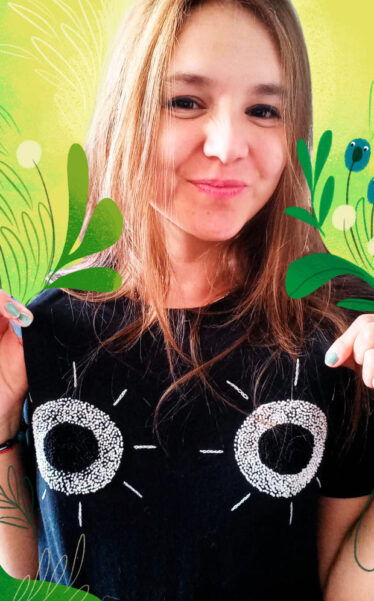
Therefore, valuing visual arts is about recognizing who we are, honoring our roots, and building a strong identity that transcends generations.
For Ana María Ospina, art is not just about creating visually appealing work. Rather, it’s about crafting narratives that educate and inspire transformation.
“Visual arts allow us to reflect on who we are and what surrounds us. They are a universal language that connects emotions, ideas, and cultures. When a child sees a drawing that represents their country, its biodiversity, or their community, they are learning to value their environment,” she explains.
Ana María believes that Colombia — her birthplace and the place that continues to inspire her — is a country filled with contrasts, yet full of warmth, resilience, and beauty.
Consequently, this belief fuels her mission: to use illustration as a medium for education, empathy, and positive societal change.
Ultimately, this journey — from experimental fine arts to purposeful illustration — allowed her to find her unique voice. Through El Perro de Traje Negro, she offers a visual world filled with identity, storytelling, and social meaning.
Colombian Illustrator Ana María continues to build bridges between art and community, leaving a mark that resonates not just in Colombia, but around the world.
A Unique Style that Educates
Colombian Illustrator Ana María Ospina’s style is not a coincidence; it is designed to spark curiosity and learning. Through the fusion of narrative, scientific, and childlike elements, her illustrations convey profound messages that can be understood by all ages.
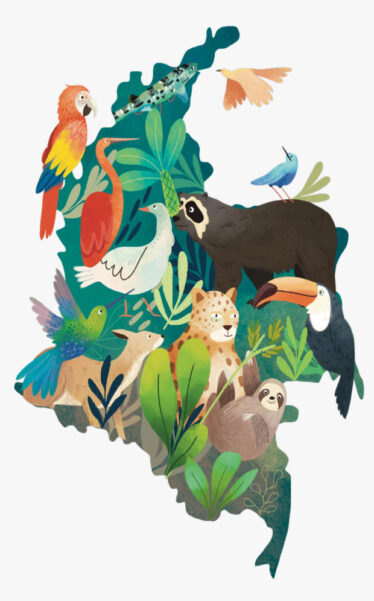
Her style serves as a bridge between the world of children, science, and storytelling.
Her compositions are filled with color, details of Colombia’s flora and fauna, and endearing characters that manage to tell stories beyond just the text.
More importantly, each of her illustrations is intended to bring the viewer closer to their surroundings, to the biodiversity around them, and to the emotions that are often difficult to express.
“I’m interested in making my images educate. If a book reaches the hands of a child, I want them to learn about their country, to recognize species like the spectacled bear, the capybara, or our butterflies,” she states.
In this way, her style is much more than a defined aesthetic; it is a pedagogical tool.
Through illustration, Colombian Illustrator Ana María Ospina aims to help children identify with the content they consume. The visual representation of their reality allows them to strengthen their sense of belonging and better understand abstract concepts.
It’s difficult to maintain a personal trademark, but I believe that as you understand your style and enjoy working with it, everything flows more easily. If you love what you do, everything flows much more smoothly.
As research shows, visual arts have a profound impact on education. Art stimulates creativity, critical thinking, and analytical ability.
Especially for younger children, art helps them develop motor skills and express complex ideas before they fully master verbal language.
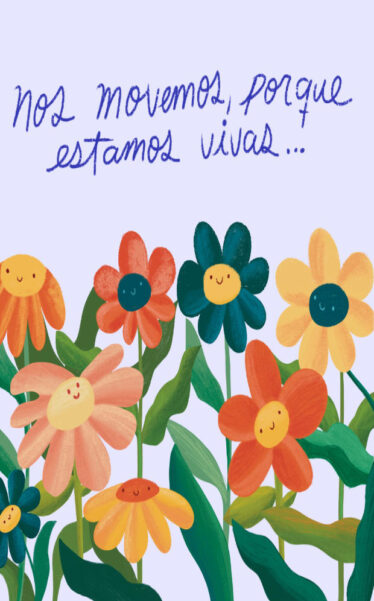
Ospina knows this, and that’s why her work is designed to encourage exploration: characters that spark curiosity, scenes that allow for the discovery of details, and visual narratives that teach without words.
Granted, it is not easy to explore the minds of young children, but she is the mother of a five-year-old boy—and he is her mentor in many things, especially in work-related matters. When she makes a book, he is the first one to see it.
Art has the power to open conversations. When a child looks at an illustration about their surroundings or endangered species, that image generates questions. Where do they live? Why is it important to protect them? That’s the first step toward education and transformation,” she explains.
This educational approach has led her to participate in emblematic projects like Sharks, a songbook published by Penguin Random House in collaboration with BioCore, the Medellín Philharmonic, the University of the Andes, and the children’s band Tu Rockcito.
“I used to be afraid of sharks because of the movie ‘Jaws.’ But this project transformed me. I understood that they are misunderstood and beautiful creatures. My job was to show that beauty so that children and parents could learn to appreciate these animals,” she recounts.
Here’s how it started: One day, Juan Pablo Mojica, the editor at Penguin, reached out and asked if she was interested in a shark project. Her answer was, “Yes!”
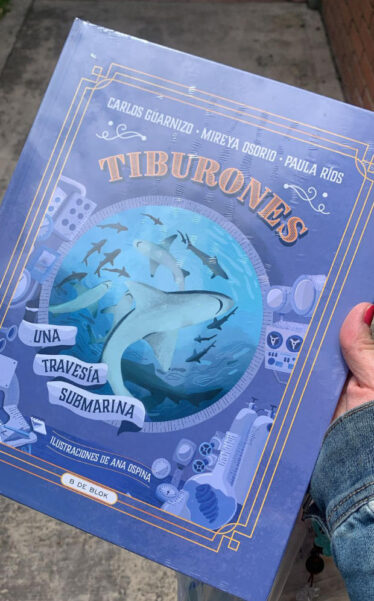
As she told me, research was key. Ospina had to learn about the more than 14 shark species from Colombia’s Pacific coast, understand their role in ecosystems, and translate all that scientific information into illustrations that were approachable and engaging for a young audience.
Laura Viera A.: What was your experience like in this project?
Ana María Ospina: It was a beautiful process from the beginning. Working with Penguin was very multidisciplinary. It was one of the most wonderful things I’ve had in my work. They are incredible; they are real pros. It was a project that truly flowed beautifully. When I didn’t understand something, we had meetings with BioCore, and they explained what was going on with each shark species. In the end, many species were featured. It was a lovely creative process. I understood that sharks are amazing, beautiful creatures. They are very misunderstood, but that’s exactly what we wanted to do—to educate these kids and parents about the beauty of these animals through the book.”
Achieving the fusion between the childlike, the scientific, and the narrative required intense research.
After all, it wouldn’t make sense to illustrate an animal that might not exist in Colombia or be representative of it.
On a more personal note, her love for flora was strongly influenced by her grandmother, who adored flowers deeply.
Clearly, these kinds of works demonstrate how art can be a driving force for education, helping new generations learn in a meaningful and fun way.
This approach, in turn, transforms her work into a powerful pedagogical resource—one that doesn’t just beautify books and materials, but also inspires audiences of all ages.
Featured Projects and Social Commitment
Beyond her unique style, Ospina has committed to projects that seek to make a real impact on society. Her collaborations with national and international institutions have provided opportunities to connect communities with their culture, history, and rights.
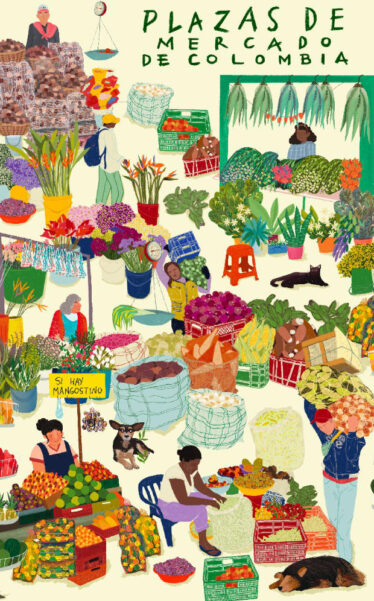
Ana María’s work is characterized by a strong social and educational commitment.
In addition to her collaboration with major publishers, she has developed projects for institutions like the UN, Colombia’s Ministry of Culture, the Ombudsman’s Office, and international brands.
These projects have not only strengthened her artistic career but also allowed her to make an impact in diverse communities.
One of the most significant was “Plazas de Mercado de Colombia,” developed in collaboration with Bogotá Chirriada.
At this point, let me take a brief moment: Bogotá Chirriada highlights the identity and pride of the country by drawing inspiration from its culture and supporting hundreds of local suppliers. It’s a Colombian design brand that illustrates Bogotá and Colombia’s popular culture and identity through creative and authentic products.

Continuing with our previous theme, the objective of this project was to showcase the cultural and social richness of the country’s traditional markets.
These spaces have historically been centers of gathering, exchange, and cultural resistance.
Marketplaces are not just places for buying and selling; they are also where culinary traditions, agricultural knowledge, and the way of life of farmers and merchants are preserved.
“I visited markets in Manizales, Cali, and Bogotá. I observed farmers, fruit vendors, and the elderly who still work in these spaces. They are places full of colors, smells, and flavors. I wanted all that to be reflected in the final poster,” she explains.
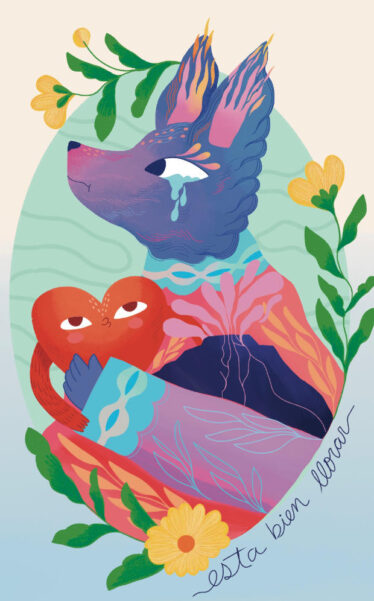
The project also highlighted the human character of these markets, where generations converge.
Grandparents pass down their experiences to the younger ones. Small producers offer the best of their harvests. Families find in these spaces a more connected and just economy.
By illustrating potato vendors, the aloe vera lady, children helping at the stalls, and even the dogs and cats roaming the aisles, Ospina captured the essence of a hardworking and resilient Colombia, deeply connected to the land.
These projects demonstrate the power of art as a tool for social transformation.
Laura Viera A.: Tell me a bit about the project with the UN.
Ana María Ospina: The UN project was very much focused on the social aspect. It was about envisioning what that unique society would look like, working together to protect its resources. Everything was tied to education, and that’s exactly what I aim to achieve as an artist—to educate. I want every project I do to be a part of what I can do to educate my territory.*
For the Ombudsman’s Office, Ospina created a comic aimed at preventing the forced recruitment of minors in rural areas.
The choice of format was not coincidental. Comics approachable and visual language, reaches young people in ways that traditional institutional documents cannot.
“The comic allowed us to reach young people in a close and direct way. We addressed tough topics, but with respect and always aiming to raise awareness. The idea was to help them understand their rights and how to protect themselves,” she states.
Laura Viera A.: What impact did it have on you?
Ana María Ospina: It was intense. Before, these armed groups used to approach the kids through violence and recruit them. Now, it’s done through words. They say, “Come, help me out and I’ll give your mom some money” or “We know your dad is sick, so come, do me a favor and deliver this package.” What the Ombudsman’s Office wanted to do was work on this concept.
Ospina wanted to address the same issue but in a different way—by creating a comic.
Unfortunately, she couldn’t be in the actual conflict zones. She would have loved to visit those places where the conflict is truly lived because, in Bogotá, we live in a bubble.
So, her contribution to the social cause was done through what she knows and loves: art. And so, a beautiful comic was created. They printed 500 copies, took them to the towns, and talked to the kids.

The comic is a narrative tool that reaches young people in an impactful way.
Ospina feels that the comic benefited everyone and is happy that it reached its destination—it’s a transformation.
El Perro de Traje Negro is also part of that mission: it is about helping, educating, and making a difference. That’s what the dog truly represents.
This commitment to children, education, and the protection of human rights is a guiding thread in Ana María Ospina’s work.
Her projects reflect a deep social responsibility that translates into clear and hopeful messages for the future of the country.
Visual Narrative in the 21st Century
In a world dominated by the digital and visual, illustration has gained even greater value.
The ability to communicate instantly, connect emotionally, and tell stories through images is an essential skill.

Ospina understands this and adapts her work to new technologies, without losing the craftsmanship and conceptual essence that defines her art.
For her, the 21st century presents great opportunities for illustrators. Digital platforms allow her to share her work with global audiences.
They also allow for collaboration on multidisciplinary projects and the exploration of new narrative forms like animation, augmented reality, and interactive books.
However, she also warns about the risks of overexposure and the loss of critical thinking in a world saturated with images.
Therefore, her work remains anchored in concept, research, and a deep commitment to the audience.
Each illustration is the result of a profound process, where idea, aesthetics, and content come together to generate a meaningful impact.
Her work invites us to look beyond the superficial. Through her art, she connects us to the biodiversity, culture, and emotions that define Colombia.
Art must serve a purpose beyond quick consumption. In the digital age, it is easy to get lost in quantity, but quality and message are still the most important.
She reminds us of the importance of preserving our natural and cultural heritage, and of educating new generations to value their environment.
Her unique style, social commitment, and passion for education make her a key artist for both the present and the future of the country.
“Art is a bridge between generations and cultures. It is a language we all understand, which can educate and transform. My dream is for my illustrations to help build a more conscious, respectful, and connected country with its identity.”
In a world where illustration can be both a simple adornment and a powerful means of communication, Colombian illustrator Ana María Ospina chooses the path of commitment and depth. Her work is a living testament that art can be a tool for change, education, and the building of identity.
Teaching and the Fusion of Art and Science
Ospina is not limited to creating illustrations; she also dedicates part of her time to training new generations of artists. Teaching, for her, is an extension of her commitment to education and an opportunity to share the richness that arises from blending art with science.
In addition to her work as an illustrator, Ana María Ospina is a university professor in the fields of children’s and scientific illustration. Teaching is an inexhaustible source of inspiration for her, a space where she can transmit what she has learned over years of creative work.
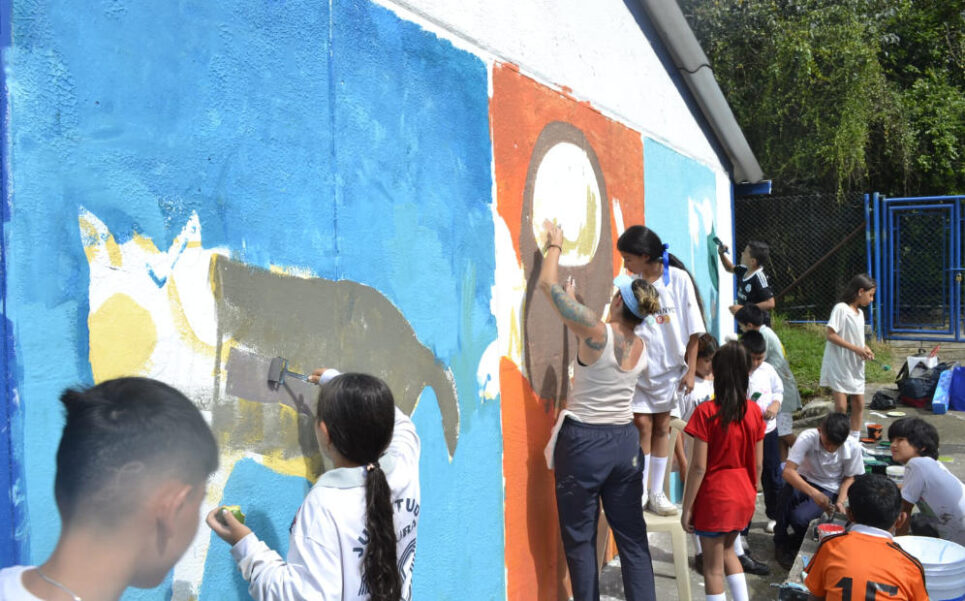
“Being a teacher fascinates me. I teach what I learn, and that motivates me to keep exploring. My students inspire me with their questions and fresh perspectives,” she says.
Her role as a teacher goes beyond teaching drawing techniques: it is about cultivating sensitivity and critical thinking in her students. For Ospina, the visual arts help young people better understand their environment, connect with their emotions, and develop skills they can apply in any area of their lives.
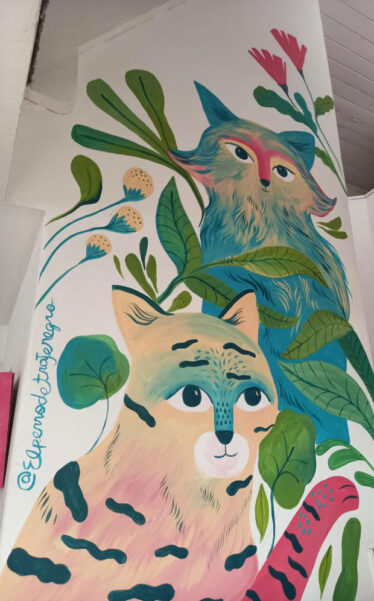
Laura Viera A.: Tell me a bit about being a teacher.
Ana María Ospina: Well, being a teacher fascinates me. I think it’s one of the most beautiful things because I love teaching what I learn. I am a student of my feelings, of what I see, of everything. It motivates me a lot to teach what I feel. That leads me to know myself better because we are always changing. Teaching everything I see is very gratifying.
Since childhood, she has had a great curiosity about biology and nature, which led her to understand that art and science are complementary disciplines.
In her classes, she often integrates scientific elements, such as the study of animal and plant species. She uses various illustration exercises that encourage observation and analysis.
“Nature is a mirror of who we are. Teaching children about biodiversity through art is planting curiosity and love for the environment. When they understand the importance of a species or ecosystem, they become defenders of life,” she explains.
This fusion of art and science creates meaningful learning. When illustrating a native bird or plant, students not only learn about color, texture, and shape but also discover facts about behavior, habitat, and ecological role.

These types of dynamics spark a genuine interest in environmental conservation.
Teaching has also allowed Ospina to reflect on her own creative process. When explaining how she approaches a project, she analyzes her strengths and challenges, which helps her grow professionally. She also values the constant exchange with her students, who nourish her with new perspectives and trends.
“My students remind me that art has no limits. Every generation brings new ways of seeing the world, and that drives me to keep innovating,” she states.
Thanks to her educational work, Ospina contributes to the training of future illustrators, scientists, and visual communicators who understand the power of art as a tool for social transformation.
In this way, her impact goes beyond personal projects. Through her classes, she plants seeds in students who will one day take art and science to new frontiers, keeping alive that connection that enriches learning and society.
Colombian Identity and International Projection
Talking about Colombian Illustrator Ana María Ospina’s work is, without a doubt, talking about identity. Her illustrations are deeply rooted in the traditions, landscapes, and cultural diversity of Colombia.
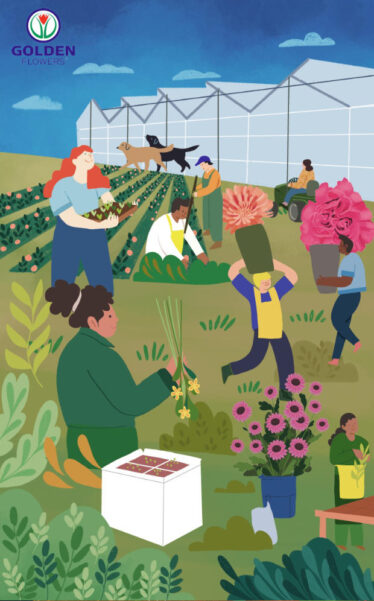
For her, art is not only a form of expression, but also a powerful way to narrate who we are and to make visible the everyday stories that weave the country’s social fabric.
Undeniably, the Colombian territory remains Colombian Illustrator Ana María’s greatest source of inspiration.
As she travels through various regions, she observes the details of daily life — elements that later find their way into her illustrations.
“Colombia is biodiversity, cultural diversity, and resilience. I am inspired by everything, from the woman selling empanadas to the changes in climate and music as I travel across the country. In two hours, you can be in a completely different landscape, and that is fascinating,” she assures.
This connection to the land is reflected in her insistence on portraying native fauna and flora, rather than exotic animals from other regions.
Her goal is for children to recognize their own country in the books they read.
Ospina believes that when readers identify with the images, it strengthens their sense of belonging and love for their environment.
Moreover, Colombian Illustrator Ana María believes that when readers identify with visual representations, their sense of belonging and appreciation for their environment naturally grows.
Ospina’s illustrations have been published in other Latin American and European countries, allowing her message to transcend borders.
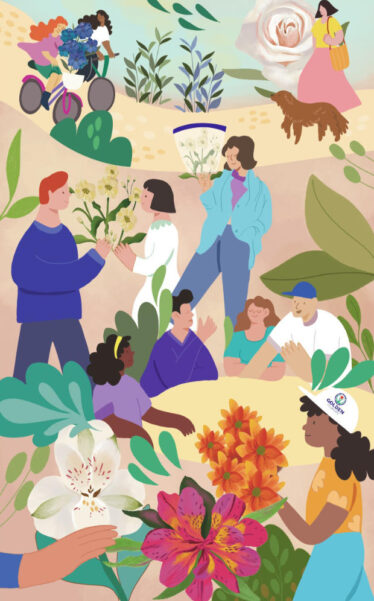
Currently, she is working with Fondo Emprender to develop illustrated products that aim to impact the international market while maintaining the local essence that characterizes her work.
“My purpose is to take what we are as a country to other parts of the world. I want those who see my illustrations to feel the warmth, diversity, and energy that defines Colombia,” she comments.
International recognition has not changed her commitment to cultural identity. On the contrary, it has given her the opportunity to highlight the richness of the country and to position Colombia as a reference in children’s, scientific, and social illustration.
In a globalized world where visual narratives are often homogenized, Ospina shows that art with solid roots can open doors and generate intercultural dialogues.
Her work is a reminder that identity is a valuable asset and that projecting it to the world is a way to build bridges of understanding and respect between cultures.
Conclusion
Without question, Colombian Illustrator Ana María Ospina has demonstrated that art is far more than an aesthetic endeavor. It is an educational, social, and cultural force capable of reshaping how we see and understand the world.
Her work is a bridge between generations, disciplines, and territories. It combines the sensitivity of narrative with the rigor of science and the power of cultural identity. She has made every illustration purposeful beyond just an image.

In her projects, there is a profound commitment to education and to Colombia, a country as diverse as it is complex.
Ospina not only documents biodiversity and social realities but invites us to value and protect them. Her work with communities, institutions, and publishers proves that art can reach distant corners and leave lasting footprints.
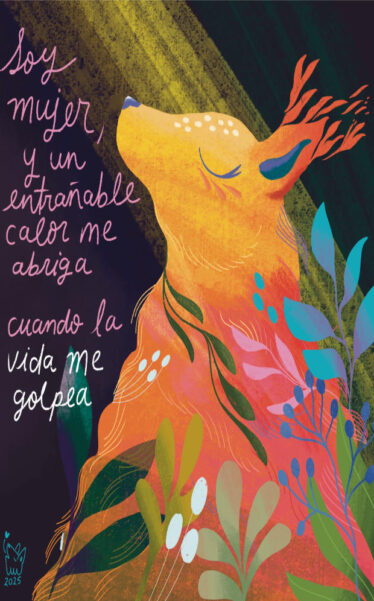
Furthermore, her role as a teacher multiplies that impact. Each student who passes through her classes acquires a broader vision of art and their responsibility as creators.
In this way, Ospina is contributing to the formation of new generations of artists capable of questioning, educating, and transforming.
The international projection she has achieved is no coincidence. Her work has deep roots in Colombian identity, giving it a unique strength in the globalized world. In a setting where visual discourses are often standardized, she shows that the local can be universal when communicated with authenticity.
Ana María Ospina is, without a doubt, a storyteller through images. Her legacy is built in each book, each poster, each comic, and each class she teaches. It is a reminder that art, when made with love, knowledge, and purpose, has the power to inspire people and plant changes that transcend generations.


